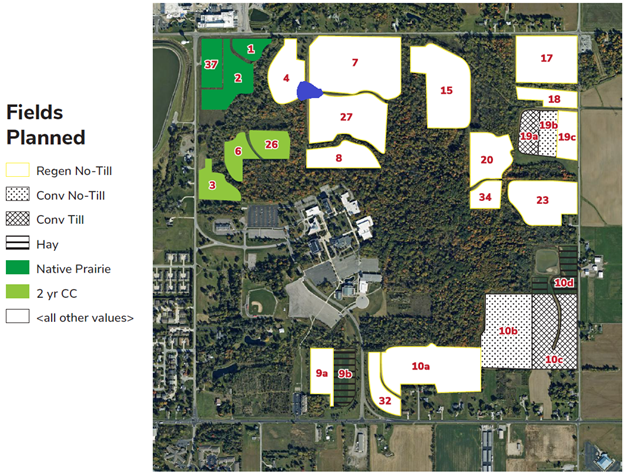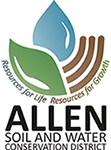OSU Ag Run-Off Treatment System
OSU-Lima Branch Campus Agricultural Runoff Treatment System Project
Project Number: ALLENSWCD-FDFARM22
Grant Award: $650,000.00
Watershed: Lost Creek (041000070305)
Location: 40°44’37”, -84°01’38”; 2.7 miles east of Interstate 75 on Harding Highway
Project Description:
The Ohio State University’s Lima Branch Campus has farmland consisting of rented crop fields surrounding the campus that drain to the Lost Creek HUC12 watershed, a headwater area of the Maumee River Watershed (see the maps of fields below). This agricultural runoff water retention project will convert some portions of cropland into floodplain, wetlands and water retention that will be used to retain and passively treat runoff before recycling back onto the fielded for the purpose of irrigating crops. Additionally, OSU proposes to monitor the hydrology and water quality of these systems by installing needed weirs and flumes and sampling equipment. The following are the specific proposed conceptual practices.
Runoff and drainage water capture, retention, and use to provide irrigation water to fields 7 and 27. This project will develop floodplain access by converting low-producing areas near the channel via berm/dike installation and/or excavation. It will also develop a water retention and treatment wetland, with irrigation equipment for cropland runoff re-use (with electrical service). The farming enterprise has agreed to allow this low yielding production field 4 to be utilized for the floodplain access and the agricultural runoff treatment and retention with a forebay (to assist in future maintenance and longevity), a wetland, and a pump “vault”. Access for maintenance, and irrigation equipment (to recycle/irrigated runoff back onto growing crops) will be installed. This aspect of the project (recycling agricultural runoff) corresponds to producer concerns regarding changes in climate and timing of rainfall for production and provides positive trade-off for taking land out of production. Utilizing runoff through irrigation is a new and direct means of reducing nutrients by applying the captured water and nutrient load during the period that crops are most in need of moisture and nutrients. Approximately 3-4 acres will be converted to floodplain retention. An estimated 40 acres of acres of row crop runoff will be captured, treated and/or reused in a combination of wetland, retention and buffer that will comprise approximately 5 acres.
Status: ON-GOING CONSTRUCTION
Contractor: VTF Excavation LLC
Expected Completion: August 31, 2024
Saturated Buffer on OSU-Lima Field 17: A saturated buffer system was installed in August 16, 2022 to treat and reduce discharge of the drainage tile from field 17. Saturated buffers collect subsurface drainage water using a drainage control structure and divert it to a drainpipe that typically runs parallel to the stream receiving tile discharge under a vegetated buffer. These often substantially reduce the amount of water directly discharging and reduces nutrients carried in subsurface discharge providing denitrification and phosphorus reduction. They require little maintenance and do not negatively affect crop yields. This system will treat approximately 12 acres of cropland drainage water treated through the new saturated buffer.
Status: COMPLETED IN AUGUST 2022

Figure 1:The Ohio State University Lima Branch Farm Fields
Climate Resiliency Concerns/Benefits: This project improves climate resiliency of the farm and receiving stream by increasing the ability to store water from more frequent concentrated rain events and to use it during subsequent periods of dry weather, providing both an environmental benefit of reduced discharge of water and nutrients (loading to streams) and an agricultural benefit of water for crops during drought and dry period. Decisions regarding sizing of water conveyances and plant choices will consider opportunities to increase climate resilience of the practices.
Monitoring and practice effectiveness – Practice effectiveness will be monitored by The Ohio State University faculty, Dr. Vinayak Shedekar. Installation will include 3 flow and water quality monitoring locations and includes continuous flow measurement and water sampling with ISCO6712 samplers.
Load Reduction Estimates: Estimates are provided in the table below.

Any questions about the project, call or email:
Vinayak S. Shedekar, PhD (Team Leader)
Assistant Professor (Agricultural Water Management),
Department of Food, Agricultural and Biological Engineering,
Director, Overholt Drainage Education and Research Program,
Director, International Program for Water Management in Agriculture
College of Food, Agricultural and Environmental Sciences
Agricultural Engineering Building | 590 Woody Hayes Drive, Columbus, OH 43210
Email: shedekar.1@osu.edu
Phone: 614-247-9965 (Office) | 203-321-5568 (Cellphone) | Fax: 614-292-9448

